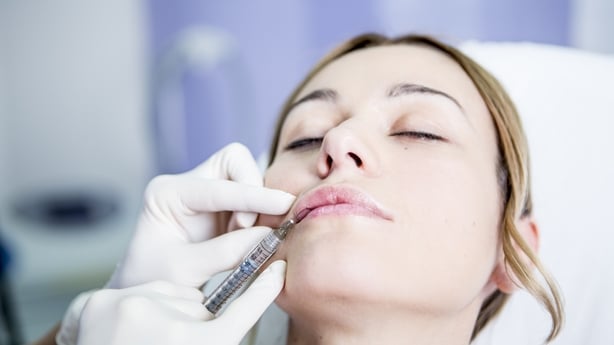Dr Rosemary Coleman, Consultant Dermatologist at Blackrock Clinic joined Today with Claire Byrne to share the pros and cons of getting dermal fillers, and what to look out for if you're getting procedures done. Listen back above.
Fillers have become more mainstream thanks to celebrities using them to boost their looks or fight the signs of ageing, but for average Joes and Janes across the world, what should you be mindful of if getting fillers?
Dermal fillers are substances, usually injectable gels and most commonly made of hyaluronic acid - a naturally occuring compound that makes up the matrix of the skin - used to plump up the face, or in medical procedures such as treating scars or Bells' palsy, Coleman said. She added that they were originally used in mainstream medicine, before gaining popularity as a cosmetic treatment.

"It's usually regarded as a semi-permanent filler, although there are a lot of nasty products out there, synthetic products available from different European countries, that won't break down. They're not as pure."
This can lead to one of the lesser known dangers of fillers, Coleman said.
"The trouble is, it doesn't just always break down. In some individuals, particularly when the skin is over-stretched, you can end up with a permanent defect because it can stimulate collagen production", Coleman explained. "We often see this as a scar, where there's a scar under pressure the scar gets very thick and lumpy."
Over-filling can lead to a "permanent, flabby, distended area of skin", Coleman said, adding that this is especially common around the lips.
Avoiding scars or other defects comes down to knowing how much filler to get, which usually will be "up to the aesthetic eye of the injecter as to which filler to place where and how much to use", Coleman said, as well as what the patient wants to look like.

"The main problem is that, when these products are injected by non-medical personnel, they are not in a position to treat any of the complications or downsides, such as if they block a blood vessel, which is a very definite risk, it needs to be unblocked urgently by injection of a drug called hyaluronidase" if it's a hyaluronic acid filler.
However, only doctors or dentists can inject this drug. Fillers can also lead to injections if done in a non-sterile environment, patients can have allergic reactions and fillers can migrate to other parts of the face or body.
As for whether Coleman has had patients come to her with complications from such procedures by non-medically trained injectors, she said she's had "plenty".
"There is an element of, if you're going to walk in off the high street because you see a billboard saying 'cheap fillers' or 'two zones for the price of one' or 'fillers starting at €99', that's a case of buyer beware. Pay peanuts, get monkeys. You're going to have to deal with the consequences."
Coleman said that one way to combat the amount of unregulated injecters springing up is to have fillers reclassified as drugs so that only medically certified professionals can inject another human being, as well as bringing in a minimum age for people looking to get fillers.

"It's very common in Ireland for 17- and 18-year-olds to go into town and get cheap fillers and pump up their lips. I hear often from patients, typically in my acne clinic where I see a lot of teenagers, and they say there's a lot of pressure to have these big lips for the Instagram and the TikTok photos and the selfies", she said.
Coleman added that getting cheap fillers from non-medical professionals at this age can lead to complications such as permanent scarring due to blocked blood vessels, blindness, "stretched, flabby skin", puffy faces and more.
She also noted how getting Botox and filler at younger ages can produce antibodies that will make the procedures less effective in the future. The messaging around preventative Botox, she said, is that "if you do Botox and fillers early, you will not age. We will prevent you from ageing.
"And that's a lie."


